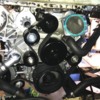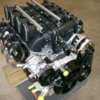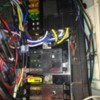The last two weeks have been jam packed with finishing systems. Our car is getting very close to being able to be driven. We are probably about five weeks out from having a drivable car.
Front Drive: For the Front Drive system, we ended up having to find two custom belts due to the placement of the pulleys. For the supercharger serpentine belt, we actually had to buy a 12 rib belt, and cut it down to an 11 rib as they didn’t make the correct size that we needed in the 11 ribs. As far as we have found, the only 11 rib serpentine belt readily available, is the stock belt that is used on the LS9, which was too long for the amount of pulleys that we are using. We decided to forgo the power steering pulley and pump for easier fitment in the car. Plus, who needs power steering? Also, check out the little block that is in the pics below. While it seems little, that block is very vital for the engine to run right in our application. It is used to plug the hole where one of the emission sensors goes.
See more pics here  Cooling System
Cooling System For the LS9, we decided to go with all molded water tubes. You wouldn’t believe the amount of time we spent searching for different shapes, sizes, and lengths for these water tubes. We ended up ordering 6 or 7 water tubes, and 5 of them fit absolutely perfectly in the car and look like they were made for our installation. We couldn’t be any happier with the cooling system.
Here is an overview of how the flow in the cooling system goes: Radiator > Electric Water Pump > LS9 > Oil Cooler > Radiator.
For the LS9, we decided to go with a water-to-oil cooler instead of the air-to-oil cooler that we used with the LS3. (Actually, one of the only Ford parts in our engine system LOL). It should be interesting to see what the water and oil temps look like with the use of the cooler.
See more pics here  Oil System
Oil System The oil system is now complete as well. As you saw in our previous post, we got the dry sump system all connected to the engine, but to finish the system, we needed to get the oil filter and oil cooler connected. In order to get the lines connected, we needed to make custom hose adapters to connect the AN style lines with the design on the oil cooler. (As a side note; it’s insane how many special adapters we have had to make to get the engine running. Thank goodness we have a machine to get all these parts pumped out quickly). We got all the braided steel lines put in and connected, and the engine is one step closer to being started.
See more pics here 
We have three systems left, the fuel, intercooler, and air intake systems. For the fuel system, we are getting a custom tank made that will fit in the front trunk. We are hoping to get about 10-12 gallons out of the front trunk, with a 3-5 gallon sump tank near the engine. This will help balance the weight in the car and should hopefully help handling. For the intercooler, we are going to mount the radiator in the front of the car right in front of the large radiator. It’s funny; when we were looking for a place to mount it, as soon as we looked under the hood, it was like the intercooler radiator was made for the Pantera. It fits perfectly (pictures coming soon). For the air intake system, we will be building side intake gills that will direct cool, fresh air right into the engine. We still need to construct the gills and mount the air filter so that will be about two weeks out.
Of course after we finish those systems, we need to run all of the electrical to run this beast, plus get the headers constructed. We are utilizing the MAST Motorsports ECU and Control System which, with the headers, should deliver around 700HP at the crank.
It’s getting really exciting over here. We can see the light at the end of the tunnel and it’s approaching fast.












